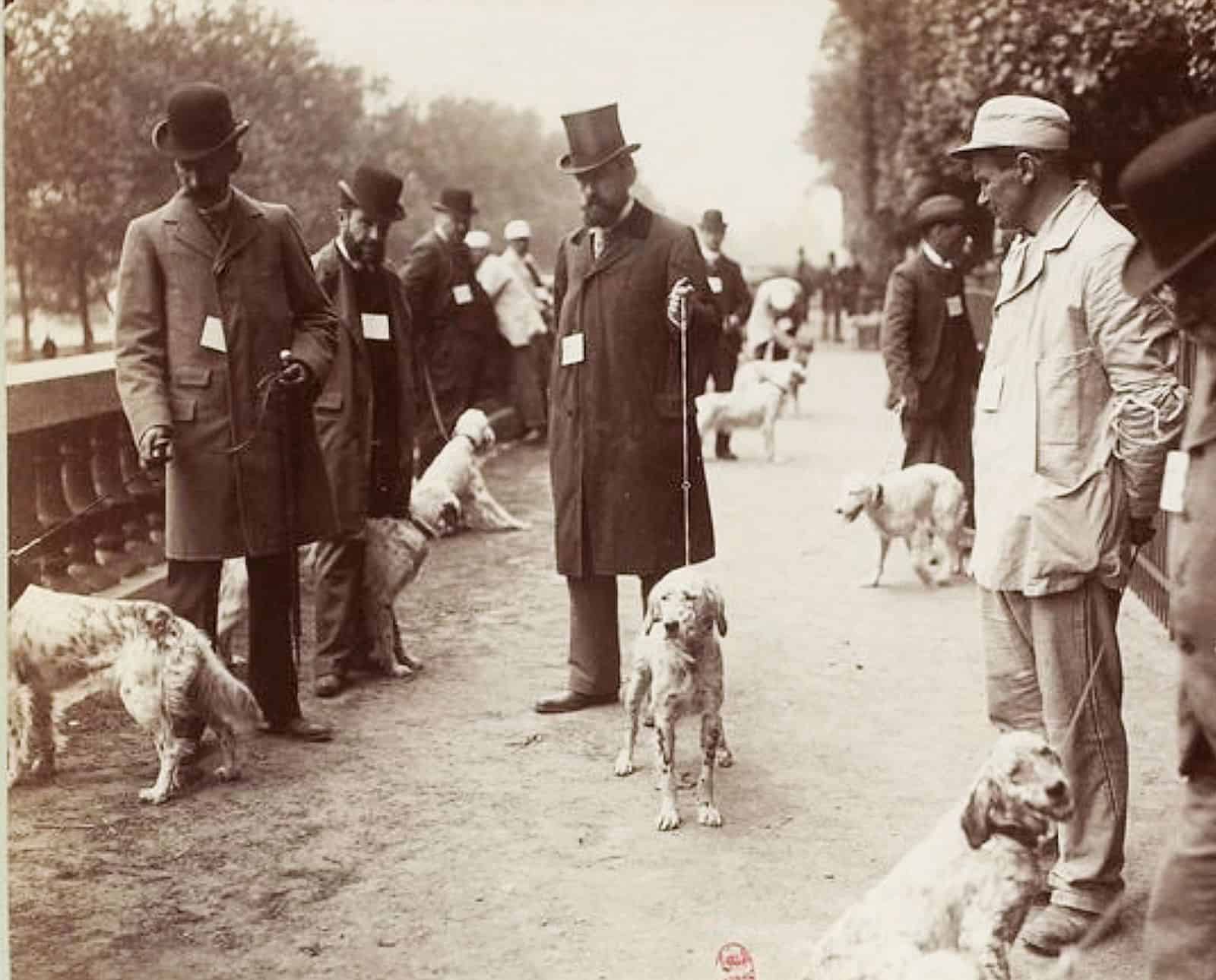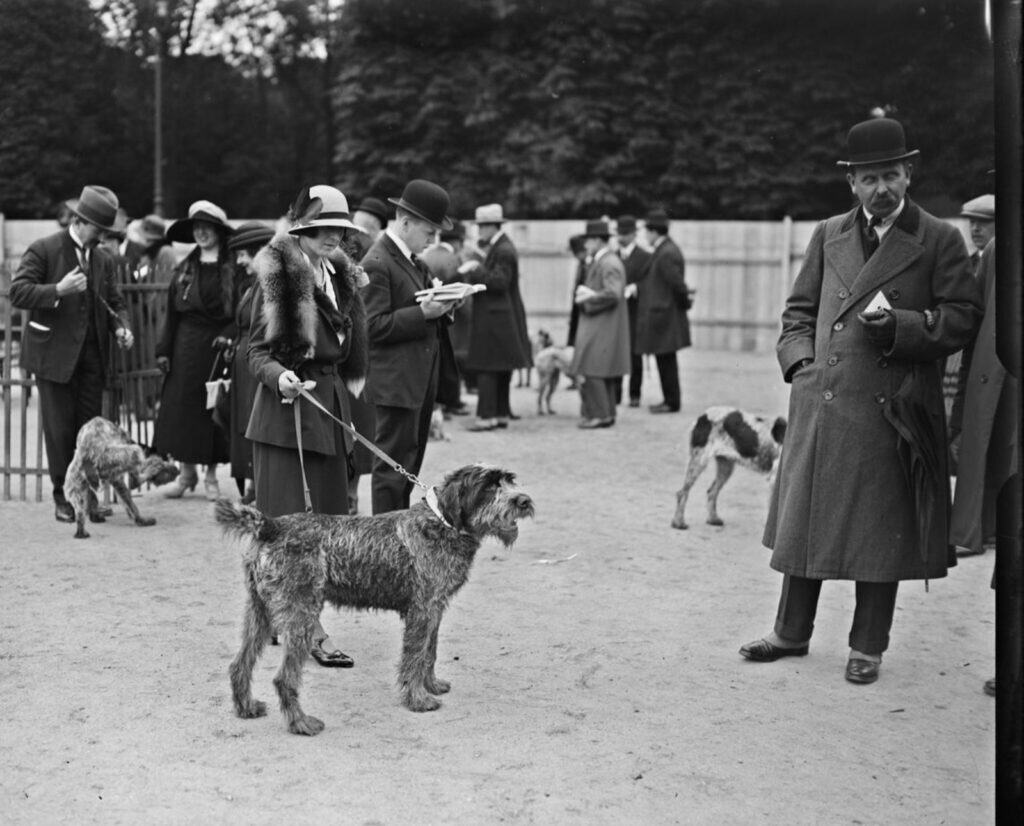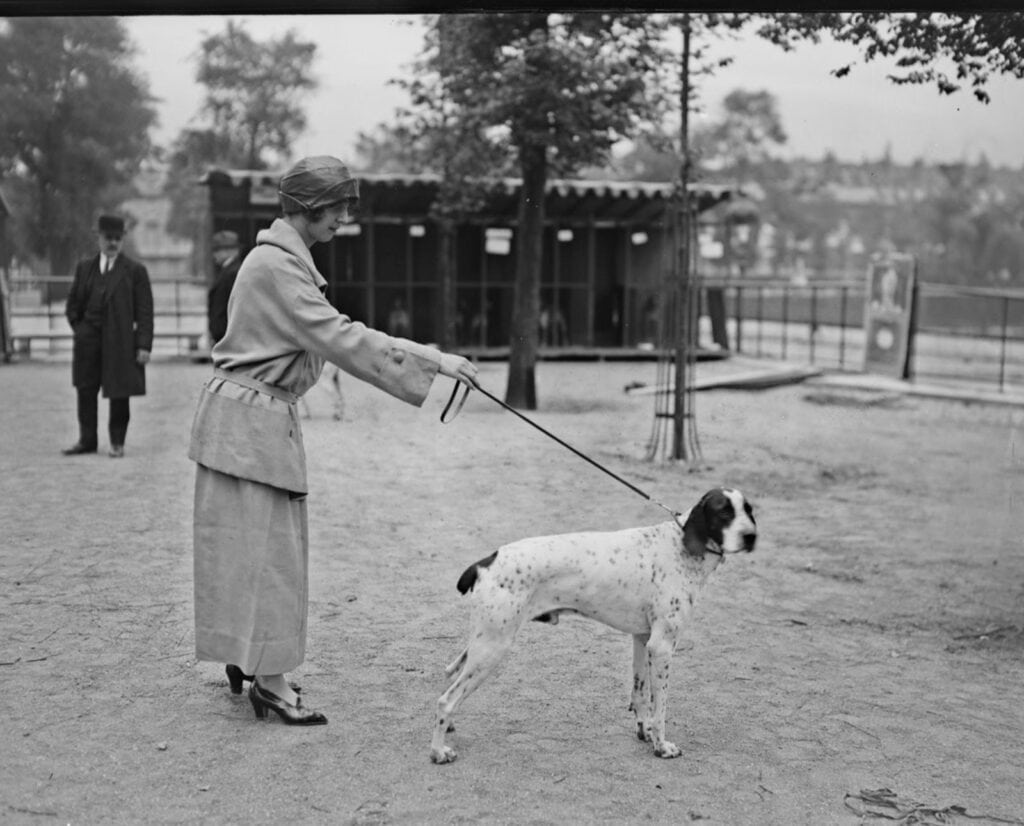Home » Hunting Dogs » The History of Dog Shows and Competitions
The History of Dog Shows and Competitions

From their home base in Winnipeg, Craig Koshyk and Lisa…
Although informal dog competitions have likely been around for thousands of years, written records of the first dog shows describe finding dogs of the “highest perfection.”
Most dogs produced little more than excrement and amusement. For non-working dogs, the social and economic value of ribbons remained unencumbered by any requirement that the dog produce a product of value or perform a specialized task. — Patrick Burns
Competitive events for hunting dogs may have started as far back as 1603. According to Frank Jackson, editor of Faithful Friends, Dogs in Life and Literature, that year, the Holy Roman Emperor Rudolf II “organized a field trial in the Castle grounds over an eight-day period, in which 480 dogs competed, some coming from as far away as Spain.” Jackson also mentions a dog show held in Brussels in 1690 and another in 1791 in Prague.
I have been unable to find any other source that mentions these events. It is also unclear what Jackson meant by “field trial” or “dog show.” However, informal competitions to determine who had the best dog have probably been around for thousands of years.
Competitive Dog Events In The 1800s
In more modern times, we find references to annual events. “Craven” (John William Carleton) reported in The Sporting Review of 1844:
During the summer, when his pack was at what he considered their highest perfection, Mr. Warde had an annual hound show at Squerries (a late 17th-century manor in southeast England), to which place were invited many of the first judges amongst the masters of hounds of that day; who were not contented by merely inspecting the pack in kennel, but had many of the best hounds brought by the huntsman singly into the room after dinner, where they once more went through the ordeal of the scrutinizing judgment of his guests, and where their individual merits were again pointed out by the enthusiastic owner of the pack.
My favorite account of an early dog show is from 1851. It describes a “fancy pet” show held in a London pub. Such events were fairly common in the mid-1800s. They were often held in connection with rat baiting contests. The popular blood sport was allowed to continue after bull baiting and dog fights were banned in 1835.

Description Of A “Fancy Pet”
In an article published on February 8, 1851 in the Illustrated London News, the newspaper’s correspondent provided the following description:
On entering the house, you pass the bar and find yourself at the end of the passage,… on looking over the door, we recognize an old acquaintance, stuffed and in a glass case; this is Billy, that extraordinary animal of rat-killing notoriety, whose feats in this particular have never been approached by any dog before or since his time. Most men would hold their dog as a good rat-killer if he destroyed 20 in five minutes; Billy could kill nearly that number in one minute, for in one of his matches, he killed (dead) 100 in five minutes and a half…
At this place, a club is held by one of the rules of which each member is expected (in fact, we believe, compelled), when he attends, to bring a dog for show, or sale, as he thinks proper; thus ensuring a good show on the club night, which is on Tuesday evenings; and here may be seen the most beautiful specimens of spaniel, Italian greyhound, and, of late years, of the Isle of Skye terrier. The club meets in the front room on the first floor, into which is brought, on those nights, a large cage enclosed with iron rails, to hold dogs, when the owners find it convenient to put them there during the evening…The show dogs, or Fancy Pets, as they are termed, are solely valued for the beauty of their respective sort.
Dog Shows Led To Cultural Changes
The popularity of rat baiting eventually diminished. It was slowly replaced by dog shows and field trials, which tended to attract members of the higher classes. In 1913, Williams Haynes wrote about it in “Buying and Selling Dogs”:
Time was when “dog fancier” was synonymous with all that is low, tricky and dirty, the very dregs of the sporting world. To-day the dog fancy is composed of very different people, and we see the celebrated lawyer, the well-known banker, the great manufacturer, together with the society leader and the workingman’s “missus,” all showing in the same ring.
The First Pointer And Setter Dog Show
The first competition to feature Pointers and setters did not take place in a field. It was held at the Town Hall of Newcastle, a large industrial city in northern England, in 1859. Billed as a The Sporting Dog Show, it was not a stand-alone event, but an addition to a poultry show. A total of sixty dogs were entered. Only male dogs were shown, and only men handled and judged them. The event was sponsored by two gunmakers who offered a pair of custom-made double-barreled shotguns as prizes.
One of the show’s principal promoters was John Henry Walsh. He was the editor of The Field magazine and a founding member of the Kennel Club. Walsh also acted as one of the judges.
Excerpt From The Newcastle Courant
A report from the show appeared in the Newcastle Courant newspaper on July 1st, 1859:
The arrangements were admirably carried out: litters , with proper divisions, round three sides of the spacious building were set apart for the dogs, which were chained and sufficiently protected by barriers from any chance of injuring or alarming the visitors; and in this section the prizes given, two valuable guns, from the manufactory of Mr. Pape, gunmaker, of this town, were probably a sufficient inducement to produce twenty-three entries for Pointers and thirty-seven for Setters, many being from different parts of the kingdom. Among them were some very splendid specimens of their kinds; and certainly on no former occasion was ever witnessed in this town so novel and, to sportsmen, such an interesting exhibition.
The most remarkable part of the article is an observation made by its writer. At the very first dog show ever to feature Pointers and setters, he realized that only the dog’s looks could be evaluated—not its abilities in the field.
… as will be noticed in the judges’ decisions, who, it is presumed, in giving their decisions as to which is the best dog, could only certify to shape, symmetry, and apparent purity of breed; for although a dog may possess all these points, he may not, for want of proper training, scent, or other defects, be the best in the field for the sportsman.
Dog Shows Became Increasingly Popular
Later that same year, another show was held in Birmingham. For the first time, breeds other than Pointers and setters were judged. In 1860, the newly formed Birmingham Dog Show Society held another show featuring 30 different breeds, judged in 42 classes. In 1863, a week-long dog show at the Cremorne Gardens in London attracted over 100,000 visitors. Attendees included members of the Royal Family.

The Spread Of Dog Shows Throughout Europe
Once dog shows began to flourish in England, they rapidly spread to other countries. France held its first show in 1863 and America its first in 1877. People from all walks of life enjoyed them as entertainment. Breeders and judges became symbols of progressive, “scientific” breed improvement.
There is no doubt that the early dog shows were indeed beneficial to sporting dogs. After all, every dog entered was owned by a hunter, and all judges were enthusiastic sportsmen. Dog shows were excellent opportunities for hunters to see a large number of dogs. They also shared information with like-minded enthusiasts.
Unfortunately, by the late 1800s, all that changed.
Excerpt From British Dogs, Their Points, Selection, and Show Preparation
In 1903, William Drury wrote in British Dogs, Their Points, Selection, and Show Preparation:
…dog shows have become a medium for money-making, and so the breeding of sporting dogs (so-called) has become a regular business in itself and entirely divorced from the proper use of the animal. Where, twenty-five years ago, there was one show, there are now one hundred; where three prizes at most were given for one particular breed, there are now a dozen or more, and the merits of the winners are thus complicated and lessened. The judges, too, are not invariably sportsmen; it is even probable that some of them have never seen the work of a setter or a Pointer in their lives.
How, then, is it possible for them to know that that dog of beautiful quality to which they give a first prize has shoulders so loaded that he could not gallop for an hour, or quarters so short or so weak that he could never get to the top of a high hill at all? …Of course, it must stand to reason that the dog should lose altogether the sporting faculties of his forbears; and the worst of it is, nobody cares a cent whether he does or not!
Dog Shows Were Profitable
Drury may have exaggerated when he wrote “nobody cares” about sporting dogs losing their natural abilities; hunters most certainly did. But people realized that, compared to field trials, dog shows were a far more effective way to make money. They could be helped at any time of the year, indoors or out, in small towns or major cities. Shows also drew far bigger crowds of spectators and featured many times more dogs and handlers. Above all, they were incredibly profitable for those participating in them.
It is not surprising that nonhunters and dog show enthusiasts started breeding and selling Pointers and setters. When they did, it wasn’t long before two types appeared in all of the British and Irish pointing breeds. “…One encouraged by bench shows, the other by the demands of practical field sportsmen,” George Shields wrote in 1891’s The American Book of the Dog.
Conformation And The “Perfection Of Form”
In The Setter, Edward Laverack wrote, “The first thing to be attended to in breeding is to consider what object the animal is intended for.” Until the advent of dog shows, that was exactly what all breeders of Pointers and setters did. They bred dogs for a specific purpose: to search out and indicate the location of hidden game. Any dog unable to do so was not even fed, let alone bred from.
Those breeders also understood that in order to perform its duties, a dog had to possess two things: an innate desire to find game, and a strong, agile body built to seek game at speed for hours. Identifying individuals with the most desire was the easy part. For anyone used to hunting over gun dogs, it was obvious. And it was easy to demonstrate to anyone seeking proof—just let the dog loose and watch it hunt.
However, identifying what Laverack called “perfection of form” presented a different challenge. How could one determine what was best for each element of a dog’s physical form? What would be the best height-to-weight ratio? The best angle for the shoulders? The best tail set, or the ideal foot shape? They lived at a time when pseudosciences like phrenology were widely accepted. They thought head shape, nose length, ear length, and even coat color played a role in their dogs’ hunting abilities.

Physical Indications Of Hunting Abilities
When dog shows came about, judges evaluating Pointers and setters looked at more than overall beauty and symmetry. They looked for things that indicated the competitor was also a good bird dog. Proper shape, length, and nose color were believed to determine how well the dog could scent game. There is certainly some basis for the idea—after all, some breeds have muzzles so short, they can hardly breathe properly, let alone scent a grouse at 40 paces. But in the 1800s, judges didn’t just evaluate the look of the nose. They assumed dogs with broad heads and thick lips scented better than dogs with narrow heads and thin lips. Some even believed ear shape and tone of voice were linked to the dog’s scenting ability.
Excerpt From The Sportsman’s Cabinet, and Town and Country Magazine
An 1833 piece in the United Kingdom’s The Sportsman’s Cabinet, and Town and Country Magazine stated:
…the inferiority of the greyhound’s sense of smell will be easily perceived: his head is narrow, while his lips are thin and compressed, and in consequence of the inflexibility and the contracted structure of the head, that breadth and extension of nerve are inadmissible; and to make up, as it might seem, for this defect, nature has endowed him with a celerity which is not to be met with in any other species of the dog.
All dogs, therefore with broad heads must possess superior organs of smell; but it does not appear that a narrow or sharp nose presents any obstacle, as the main bulk of the olfactory organs is situated in the head; but I think it is abundantly evident, that a very long nose (like the greyhound,) must always be detrimental, since the impression of scent, externally caught, must have farther to travel to the brain.
I have frequently thought that the size of the ears, and also the voice, as far as relates to hounds (pointers and setters inclusively, as they are evidently of the hound tribe) a criterion of the quality of the nose. The Talbot has the deepest and most powerful voice of any dog; the progressions are obvious; and thus we may form perhaps a tolerably accurate criterion of the sense of smell.
The Divide Between Field And Show
Today, we have a far better understanding of what makes a bird dog tick. We no longer believe that the shape of a dog’s ear determines how well it hunts. Breeders on both sides of the field/show divide today agree with what Laverack wrote 150 years ago: “One of the first objects to obtain, if possible, is perfection of form.” Yet, a deep divide between the two sides still exists. Why?
Like everything in dogdom, the answer is complicated. I could write an entire book about it. But that would mean trodding over some pretty well-covered ground. Plus, in the end, I doubt I would change anyone’s opinion on the matter. So, in another article yet to come, I will closely examine the most crucial aspects of the show/field divide as it applies to bird dogs and how the two sides could resolve some of their differences.
From their home base in Winnipeg, Craig Koshyk and Lisa Trottier travel all over hunting everything from snipe, woodcock to grouse, geese and pheasants. In the 1990s they began a quest to research, photograph, and hunt over all of the pointing breeds from continental Europe and published Pointing Dogs, Volume One: The Continentals. The follow-up to the first volume, Pointing Dogs, Volume Two, the British and Irish Breeds, is slated for release in 2020.




Very interesting listen – thanks.